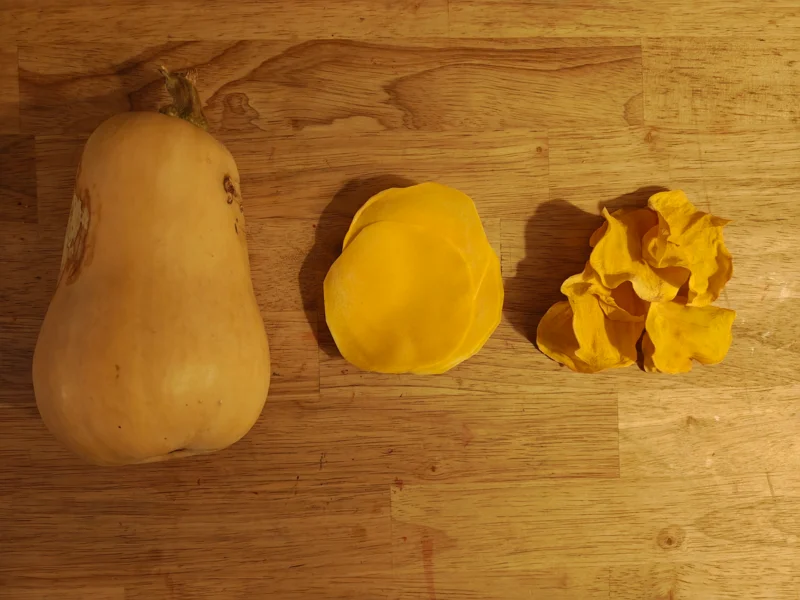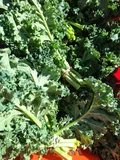TL;DR
On a perfectly sunny and breezy fall day, we moved chicken coops then harvested kale, carrots and broccoli rabe. After lunch, we collected soil samples from some of the fields and packed the van for Essex distribution.
In the evening during my online course call, I started dehydrating butternut squash chips, hot peppers, and leeks. Squash chips through a mandolin slicer with a sprinkle of salt are, as the kids say, fire. I wouldn’t have expected that their starch converted so well but it did; they’re a fantastic snack and another score for trying new things I wouldn’t have expected to work so well.

Getting Faster at Moving the Coops
Every time I move the chicken coops with Jamie, it feels a bit faster than the last time. It could just be a psychological coping mechanism for laborious, repetitive tasks, but looking at time signatures of the videos, I think we’ve just gotten into a groove about what to do and how to do it efficiently.
Variability in Farm Tasks
Every task around the farm seems to have an optimal number of people working on it. There are ‘constrained’ tasks…processes constrained by steps that have to be done in a certain order (sequencing) such as moving chicken coops and ‘unconstrained’ tasks…processes that can be done in any order (in parallel) such as cleaning and bunching produce. From my former tech career, variability and sequencing like what Goldratt’s Theory of Constraints discusses as ‘statistical fluctuations’ and ‘dependent events’ are always on my mind in any operational process.
For the coop moving, with only one pair of hands, you have to get up and down off the tractor many times, to adjust the alignment of the hitch and set the pin, move the wheel stop(s) before unhitching, etc. With two pairs of hands, it goes much faster, even less than half the time otherwise. But this is a two-person job, so a third person would mostly be standing around for this part of the process.
Likewise, timing and volume are important factors to consider when determining the optimal number of people for a task. If you have to harvest 4 types of produce before afternoon distribution and only 3 people, it’s better to harvest just the volume of what you need to limit the time spent rather than trying to harvest more than what you need of a specific crop. Also, factoring in weather forecasts, crop maturity, pest pressure, and other factors can also impact the decision to put a certain number of people on a task.
Not to be pedantic, this is just to elaborate on why farmers are in a constant push and pull of prioritization and efficient resource use. It all comes down to constraints and in particular, real-time changes on in them hour by hour on the farm. When things line up optimally, you get what you need and have a little time for ‘project’ work…such as greenhouse cleanup or…soil sampling.
Sampling the Soil
Soil is…complex. Popular thinking about analysis of soil looks at it from three angles: structure, biology, and chemistry (mineral composition). Soil testing reduces this to mostly structure and chemistry because once dug up, biology disappears quickly. Dead protozoa, bacteria and fungi do contribute to organic matter (OM), but after being baked in a lab, what mostly shows up on the test results is the mineral composition and other structural components.
Taking samples from fields is an important part of soil management. When you grow crops, you deplete the soil of various levels of what the crops need to develop. Soil testing after the growing season helps farmers understand the health of their soil and make informed decisions about how to improve it.
Farmers send their samples to a lab because advanced on-site testing is not practical or cost-effective. To do so, they take representative samples from their fields then mix the samples together and dry them a bit before sending them off. They also tend to use the same lab year over year because, even if the lab in some way skews the results compared to another lab, using the same lab ensures consistency.
I’m by far no expert in any of this, but I’m learning as I go and these kinds of tasks prompt me to ask more questions and seek out more information. Extension offices do a great job of explaining things in a way that’s easy to understand.
AI Summary from Field Notes
It’s amazing to me that my homelab LLM (largely based on Qwen3) is able to correct some of my pronunciations of Chinese vegetable varieties we grow here. For instance, Choy sum (菜心 / cài xīn) which in English is pronounced “chai sim” and that’s what we call it here. Even though it simplified it to the improper noun “choisum” instead of sticking with one of commonly used proper nouns, it self-corrected my narration and got the rest of the notes right. Things like “adaptability to local climate and soil” and “explore market demand” were pretty much what I had in mind when I was narrating the field notes.
Summary
Main Themes:
- Farm Operations & Harvesting: Preparing for and executing crop harvests (carrots, kale, Choisum), equipment management, and logistical tasks.
- Collaboration & Teamwork: Working with diverse team members, including cross-cultural interactions with Chinese agricultural knowledge.
- Soil Management: Learning soil sampling techniques for agricultural analysis.
- Crop Diversity: Introducing a new crop (Choisum) and exploring non-traditional varieties for the region.
- Logistics & Market Distribution: Preparing the electric van for local market sales.
Activities Performed:
- Washed and prepared bins for harvesting.
- Moved chicken coops and assisted in field tasks.
- Harvested carrots, kale, and Choisum.
- Washed, binned, and stored produce.
- Conducted soil sampling in fields.
- Helped with barn chores and packed the electric van for market.
New Things Encountered:
- Choisum: A Chinese brassica variety (crisp, fibrous, grassy broccoli flavor).
- Soil Sampling: Learning to collect representative samples while avoiding edge areas and weedy patches.
- Cross-Cultural Collaboration: Engaging with team members from China for agricultural insights.
- Market Distribution: Packing the electric van for the Essex general store.
Questions for Research:
- How to optimize Choisum growth in New England?
- Improve soil sampling accuracy and standardize protocols.
- Assess Choisum’s adaptability to local climate and soil.
- Explore market demand for Choisum in local or CSA programs.
- Learn about Chinese agricultural practices for brassica varieties.
Suggested Actions:
- Document Choisum’s growth, harvesting, and flavor for future reference.
- Create a soil sampling protocol guide for the team.
- Research other Chinese brassica varieties for crop rotation.
- Collaborate with team members to share Choisum cultivation insights.
- Track customer feedback on Choisum in local markets.
Part 1
Main Themes:
- Farm Operations and Harvesting: Preparing for harvest, moving equipment, and harvesting various crops (carrots, kale, Choisum).
- Collaboration and Teamwork: Working with Jamie and others, including cross-cultural collaboration with team members from China.
- Soil Management: Soil sampling for agricultural analysis.
- Crop Diversity: Introducing a new crop (Choisum) and exploring non-traditional varieties for the region.
- Logistics and Distribution: Preparing the electric van for market distribution.
Activities Performed by the Intern:
- Washed and prepared bins for harvest.
- Moved chicken coops.
- Harvested carrots and kale.
- Washed, binned, and stored harvested produce.
- Took part in soil sampling (collecting samples from fields).
- Helped with chores at the barn.
- Packaged the electric van for market distribution.
New Things Encountered:
- Choisum (a Chinese brassica variety): A new crop with distinct characteristics (crisp, fibrous, grassy broccoli flavor).
- Soil Sampling Technique: Learning to collect representative soil samples from fields (avoiding edge areas, weedy patches, etc.).
- Collaboration with Chinese Team Members: Exposure to cultural and agricultural knowledge from team members with Chinese heritage.
- Market Distribution Process: Packing the electric van for the Essex general store.
Questions and Future Research Areas:
- Choisum Cultivation: How to optimize growing conditions for Choisum in New England.
- Soil Sampling Methodology: Refining soil sampling techniques for accuracy and consistency.
- Crop Adaptability: Whether Choisum thrives in the local climate and soil conditions.
- Market Potential: Exploring the demand for Choisum in local markets or CSA programs.
- Cultural/Agroecological Insights: Learning more about the agricultural practices of Chinese brassica varieties.
Suggested Actions:
- Document Choisum Characteristics: Record detailed notes on its growth, harvesting, and flavor to guide future cultivation.
- Share Soil Sampling Protocols: Create a guide for the team to standardize soil sampling procedures.
- Research Choisum Varieties: Investigate other Chinese brassica varieties for potential inclusion in the farm’s crop rotation.
- Engage with Chinese Agricultural Knowledge: Collaborate with team members to share insights on growing and maintaining Choisum.
- Monitor Market Feedback: Track customer reactions to Choisum in local markets to assess its viability.
[end of post]
Enjoy Reading This Article?
Here are some more articles you might like to read next:





